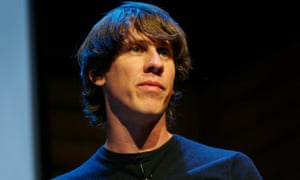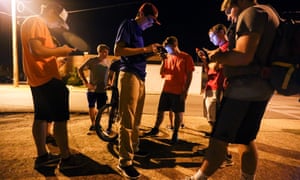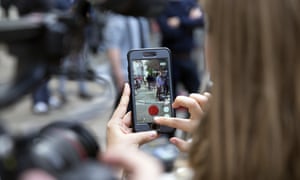It has only taken a week for Pokémon
Go’s creatures to pop up all around the planet – but their journey really began
in 1996
Playing Pokémon Go in New York:
augmented reality brings the creatures out of the game and into the real world.
Photograph: Anadolu Agency/Getty Images
Returning home on Thursday
afternoon, I was stopped by two 10-year-olds standing at the top of my road.
“Are you playing Pokémon Go?” one asked. When I said I was, they
went wild.
“Oh my days! There’s a Gengar over there,
and there’s a gym over there and that woman’s playing it too. Everyone here is
playing it! What level are you? How many Pokémon do you have?” At this point,
the game had been out in the UK for less than 12 hours.
This is what a phenomenon looks like.
But while it feels as if it appeared
from nowhere, Pokémon Go is painstakingly assembled from what came before it:
an overnight success 20 years in the making.
“I love the game. I’m running around
and playing it a lot. But it’s not like it came out of the blue,” says Dennis
Crowley, whose life has been built around location-based games. As a technology
graduate student at New York University’s Tisch School of the Arts interactive
telecommunications programme in 2004, he built Pac-Manhattan, a real-life version
of the Pac-Man arcade game on the streets of Manhattan. From there, he created
location-based games including ConQwest and Dodgeball before co-founding
Foursquare – a game-type app that lets users check in to locations to earn
points and meet friends – in 2009.

Dennis Crowley, co-founder of
Foursquare: ‘I don’t know it would have worked if someone made up characters
and called it something crazy.’ Photograph: Anna Gordon
Crowley points out that much of the
game’s success rests on the longevity of Pokémon itself. Originally a pair of
Game Boy games released in Japan by Nintendo
in February 1996, in early Pokémon a player travelled through the region of
Kanto attempting to capture 150 of the titular creatures and train them to
battle the Elite Four and become the champion of the region.
By the time the games hit Europe in
1999, they had extended into comics, cartoons and a trading card game, the last
of which was arguably more popular at its peak than the Game Boy games
themselves.
How augmented reality technology erases the human v
machine boundary
Read more
Eventually, the Pokémon craze died
down, at least in the west, but the series never went away. Pikachu, the
“electric mouse” Pokémon that has become the game’s mascot, has remained
recognisable worldwide, and the main game series, still one of Nintendo’s top
sellers, is entering its seventh generation.
At the same time, a Google
subsidiary called Niantic was building its own, much smaller fanbase. Created
from the remnants of an acquired mapping firm called Keyhole, which had built
what became Google Earth, Niantic’s first major product was Ingress: a
location-based social game in which players compete for control of points
located at physical landmarks in their neighbourhood while increasing their own
power in the conflict by tapping into minor landmarks as they play.
If it sounds familiar, that’s
because Pokémon Go is almost totally based on Ingress. Niantic gained
independence from Google in August 2015, a move that freed it to seek
commercial partners for future projects, and the first one, with the Pokémon
Company and Nintendo, was a winner. Crowley points out that the familiarity to
millions was key: “I don’t know it would have worked if someone made up
characters and called it something crazy.”

A group of teenagers playing Pokémon
Go in the US. Photograph: Crystal Vander Weit/AP
The resultant game has been
simplified to the point where it can be played and understood by almost anyone,
but it has Niantic’s four years of experience behind it.
Which is why it is somewhat strange
that Pokémon Go is successful despite – rather than because of – the actual
app. “The hardest part of this game is not hurling your phone on the ground
when it crashes just as you’re about to catch a very rare Pokémon,” says Sarah
Jeong, a writer and lawyer who has been obsessed with the game since its
release in the US a week ago. “It also has no explanations for any of the
mechanics,” she adds.
It’s true: everything from how to
fight in a Pokémon gym, to the specifics of catching Pokémon, to almost the entire
user interface is unexplained. But for Jeong, that adds to the joy at the heart
of the app – its relationship to the real world.
“The funny thing is that the user
unfriendliness just means that players will talk to each other more in physical
space when they run into each other – asking for tips and tricks and basic
explanations.” Like the kids on my street, it’s hard not to want to talk to
other players you meet on the go – a seemingly accidental quirk of the game,
but one that helped it go superviral.
“The game itself isn’t the fun
part,” says Jeong. “The fun part is going and taking a walk and seeing things I
don’t usually see … It’s a very social game – you don’t have to pay too much
attention to it so you can chat while playing, or goof around by taking photos
of your friends with Pokémon on their faces.”
Those photos are the other key to
Pokémon Go’s phenomenal growth. The feature, known as augmented reality (AR),
amplifies the premise of the game: that you can be a Pokémon trainer in real
life. When you encounter a Pokémon, rather than simply seeing it standing on a
green field, it is instead superimposed on a live image from your camera,
bringing the creatures out of the game and into the real world.

A woman plays Pokémon Go while
waiting for the new prime minister in Downing Street. Photograph: Carl
Court/Getty Images
The feature has given the game a
presence on social networks to match the physical crowds of people who now
appear around rare Pokémon with little notice. If you have been on Facebook or
Twitter in the past week, doubtless you too will have seen the pictures of
Pokémon in homes, workplaces and schools. The Guardian’s editor-in-chief even
has one in her office.
“The AR part is the part that makes
it seem new and interesting and magical. But there’s a question of how to keep
people engaged,” Crowley says. “If you get a bunch of game designers in a room,
they’ll all say how hard it is to make something interesting for a prolonged
period of time. To make something interesting for years is particularly
challenging.” Crowley’s own Foursquare, at the venerable age of seven, has had
to radically transform itself over the years to keep users entertained.
Pokémon Go could be the next Draw
Something or Trivia Crack: going from unknown to ubiquitous to dead in a month
or two. Or it could become more like FarmVille or Clash of Clans, turning its
ubiquity into a sustainable long-term fanbase.
For Jeong, longevity is a moot
point. “I’m having a blast right now. Right now is good enough for me.”

No comments:
Post a Comment
comment